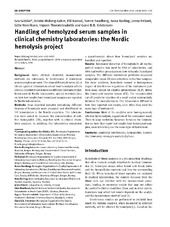Handling of hemolyzed serum samples in clinical chemistry laboratories: The Nordic hemolysis project
Gidske, Gro; Aakre, Kristin Moberg; Rustad, Pål; Sandberg, Sverre; Norling, Anna; Pelanti, Jonna; Henriksen, Gitte; Thorsteinsdóttir, Ingunn; Kristensen, Gunn Berit Berge
Peer reviewed, Journal article
Published version

Åpne
Permanent lenke
https://hdl.handle.net/1956/22588Utgivelsesdato
2019Metadata
Vis full innførselSamlinger
Originalversjon
Clinical Chemistry and Laboratory Medicine. 2019;57(11):1699-1711 https://doi.org/10.1515/cclm-2019-0366Sammendrag
Hemolysis of blood samples is a pre-analytical challenge that often leads to sample rejection in medical laboratories [1]. Hemolysis occurs when blood cells break down and the intracellular contents leak into the surrounding fluid [2]. When hemolyzed blood samples are analyzed in medical laboratories, the content released from the blood cells can interfere with the measurement procedure, leading to erroneous results that may not reflect the patient’s clinical condition. How, and to what extent, hemolysis may affect test results depends on the analyte and the measurement method used [1]. Interference studies are performed to establish how much the various analytes, when measured by different methods, will be affected by hemolysis [3]. Based on the results, instrument-specific cut-off points are determined to prevent hemolysis from significantly affecting the clinical interpretation of laboratory results. Most instruments used in medical laboratories today can measure cell-free hemoglobin (Hb) in individual blood samples and transfer the result to the laboratory information system (LIS). These Hb results may be combined with predefined Hb cut-off points, enabling the laboratories to automatically reject or comment upon test results significantly affected by hemolysis [4]. Cut-off points for rejection of samples are commonly recommended by the manufacturers of in vitro diagnostic (IVD) analytical systems. The Clinical and Laboratory Standards Institute (CLSI) recommends that the laboratories verify the intended usefulness, strengths and limitations of manufacturer-derived cut-off points before they are implemented [5]. This is time and resource consuming for the laboratory, and may be difficult as manufacturers’ package inserts often lack information about experiment design and how the cut-off points were defined [6], [7], [8]. Consequently, many laboratories use the manufacturers’ cut-off points for hemolysis, without further verification studies [8]. The Nordic cooperation of External Quality Assurance (EQA) organizers, EQAnord, performed a large interference study in 2002 to obtain data on the effect of hemolysis on analytical performance on different clinical chemistry instruments [9]. The aims of the current study were (1) to obtain updated information about how hemolysis affects clinical chemistry test results on different instrument platforms, and (2) to obtain data on how test results from hemolyzed samples are reported in medical biochemistry hospital laboratories in the Nordic countries.